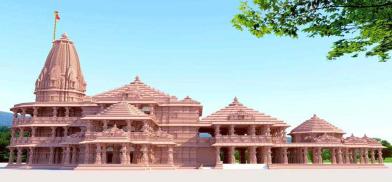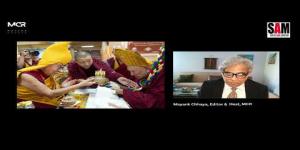Ancient grandeur of Hindu culture and civilisation that lies suppressed by history
That we were far more technically advanced and superior than what our western and leftist historians would like us to believe isn't a notion but a fact backed and supported by archaeological findings like in Dwarka, Sinauli, Mehrgarh and Hampi

Some 135 km east of Lucknow, the state capital of India's most populous state, Uttar Pradesh, lies Ayodhya. The town, the focal point of India's right-wing politics for more than three decades now, is considered the birthplace of the Hindu deity, Lord Ram.
For Jain, their five Tirthankaras (spiritual teachers) were also born there; for Buddhists, Lord Buddha gave lectures in the region known as Awadh. The city symbolizes India's glorious yet tumultuous past, containing the scars of historical wounds and civilizational conflicts.
The most recent one was in 1992, when the members of Vishva Hindu Parishad (VHP), a right-wing Hindu organization, and other allied groups demolished the Babri Mosque, built somewhere between 1528-1529 by then Mughal ruler Babur.
For Hindus, which account for almost 80 per cent of the country's population, the mosque was built after demolishing temple commemorating the birthplace of Lord Ram. For India, called a ‘civilizational state’ by the present ruling disepensation which was subjected to multiple foreign invasions, history has never been a collection of just ‘fairy tales’ of diversity only.
Destructions of religious sites, including temples, centuries ago, by then rulers remain in people's political consciousness. "Hindu Temples – What Happened to Them", a two-volume book by Sita Ram Goel, Arun Shourie, Harsh Narain, Jay Dubashi and Ram Swarup, provides authoritative descriptions of such depredations.
The book's first volume, published in 1991, lists 2,000 mosques claimed to have been built on Hindu temples. In support of these claims, the authors referred to multiple books written by then Muslim historians of the period and inscriptions found on mosques.
The second volume excerpts from medieval histories and chronicles and from inscriptions concerning the destruction of Hindu, Jain and Buddhist temples. The authors claim that the material presented in the book is "the tip of an iceberg".
India's actual history, over the centuries, has been altered and adulterated with misinformation. From Mughal historians, the British, and Europeans to India's leftists, Marxists, pseudo-intellectuals, and hate-India ilk, including those sympathetic to India's grand old party, Congress, played their roles in this.
Many of India's historic Hindu temples are magnificent architectural wonders and signify our scientific knowledge and technological capabilities in those times. Indians, since time immemorial, were aware of the importance and applications of advanced technologies in warfare.
But all these have been systematically rejected as myths-- in some cases also ridiculed--by Western scholars, and Indians influenced by the West.
Before British rule, the country was subjected to large-scale destruction of its material wealth, cities, seats of learning, traditional knowledge, culture and traditions. Ravi Kumar Gupta mentioned it in his book, titled "Institutions That Shaped Modern India: DRDO (Rupa)."
That we were far more technically advanced and superior than what our western and leftist historians would like us to believe isn't a notion but a fact backed and supported by archaeological findings like in Dwarka, Sinauli, Mehrgarh and Hampi. The advanced architecture of Khajuraho, Halebeedu, Madhera, Virupaksha and Meenakshi temples are another.
Detailed descriptions of plastic surgery and related medical procedures are many brilliant examples.
The caves of Ajanta and Ellora, including elephants and the grand 32-metre-high Kailash temple, carved and chiselled out from a single rock there, couldn't be possible without a high-level understanding of science and technology.
The metallurgy of the Ashoka pillar remains a surprise to many even now.
Behind the vandalism, destruction, and pillage of many Hindu temples and sculptures lies disdain and jealously. Artistic sculptures and artefacts—many rare and exotic—were looted on a large scale by the pre-Mughal, Mughal, British and European rulers. And, there is no counting of these stolen items.
The demolition of the Babri Masjid in 1991 shook India like no other incident. However, the root lies in the unresolved nature of many of these disputes—even after seven decades of India's independence— wherein mosques and other Islamic structures are claimed to have been built on the sites of demolished temples.
The possibility of such incidents repeating in the future couldn't be ignored either, as the decades-old Gyanvapi mosque- Kashi Vishwanath case has already reached the Supreme Court.
In the same context, Neena Rai’s book, “Amazing Ayodhya: The Splendid Ancient City of Lord Rama”, published last year, came as a breath of fresh air. The long-awaited book, with a well-researched narrative, indicates how the ancient city of Ayodhya was one of many marvellous regions of Hindu civilization.
Explaining the meaning of the word Ayodhya, originating from a-yudh (war), something that can’t be conquered, the book answers many questions about the holy city and the history of Hindu religion, way of life, culture, and traditions, among others.
Like many other ancient Indian towns and cities, Ayodhya too was designed on a grid pattern, surrounded by the ‘parikha’, a protective moat with wild animals as an effective all-around defence. Then there was the girdle of trees forming a dense jungle.
If we think about the closest possible examples with similarities, it would be today’s Chandigarh, a north Indian city, and Gandhinagar in the west.
Significantly, Ayodhya was famous even before the birth of Lord Rama. Manu, believed to be the first man and king among men according to Hindu mythology, built Ayodhya. Valmiki, the harbinger-poet in Sanskrit literature and author of the epic Ramayana, wrote about it.
However, once it became the birthplace of Rama later, the city became a much sought-after pilgrimage destination among Hindus.
King Dashrath, the father of Lord Rama, had a Chaturangi Sena, the army of four forces, comprising infantry, cavalry, elephantry and chariotry— the latter two terms coined to denote forces of elephant-mounted and chariot-mounted troops/field commanders.
These forces were also organised as ‘akshouhinis’, with each akshouhini (divided into ten anikinis) comprising 21870 elephants, 21870 chariots, 65610 horses and 109350-foot soldiers, which amounted to 2,18,700 warriors.
In the eighteen days of the Kurukshetra war, also known as the Mahabharata war, eighteen akshouhinis were destroyed.
Neena Rai's' book, six parts containing twenty-nine chapters, covers many aspects of Ayodhya as a kingdom, a city, and a part of Hindu civilization. Part I describes the city’s establishment, its creator, Manu, and the timing and the unbroken link of the solar dynasty from Satya yuga to Treta yuga.
In Hinduism, there are four epochs: Satya Yuga, Treta Yuga, Dwapar Yuga, and Kali Yuga, the present one. Satya Yuga lasts 4,000 divine years, Treta Yuga, 3,000, Dwapara Yug, 2,000 and Kali Yuga, which is ongoing, will last for 1,000 divine years. One divine year equals 360 solar/human years.
The book's Part 2 describes the location of Ayodhya, its reach and scale and those of the Kosala Kingdom. And also how many kings were under Dasharatha's' dominion. The third part deals with the shape, size, population, and unique design to deal with external threats.
The city's roadways, buildings and structures of residences/ palaces are in the fourth part. Part 5 elaborates on the types of weaponry and decoding of the Attalla and the mysterious shataghnii weapon systems.
And the last part covers animals living there, the Chaturangi Sena, the Akshouhini, importing horses, hippopotamuses and elephants, breeding elephants, birds of Ayodhya, and pets at Prince Rama's palace. It also details why Sita, his wife, requested Rama to get her the golden deer.
Those who don't study history are doomed to repeat it. The warped politics has kept India deprived of its organized learning of its ancient culture, history, and even modern/post-Independence history. In such times, the role of scholars, writers, and researchers, becomes even more critical; they are crucial for dealing with our present and future and can fill the gaps.
Such books ideally should be translated into other regional Indian languages and those of other countries where Hinduism's influence has reached.
(The author is a strategic analyst and former Defence Ministry and Indian Army, spokesperson. Views are personal)













Post a Comment